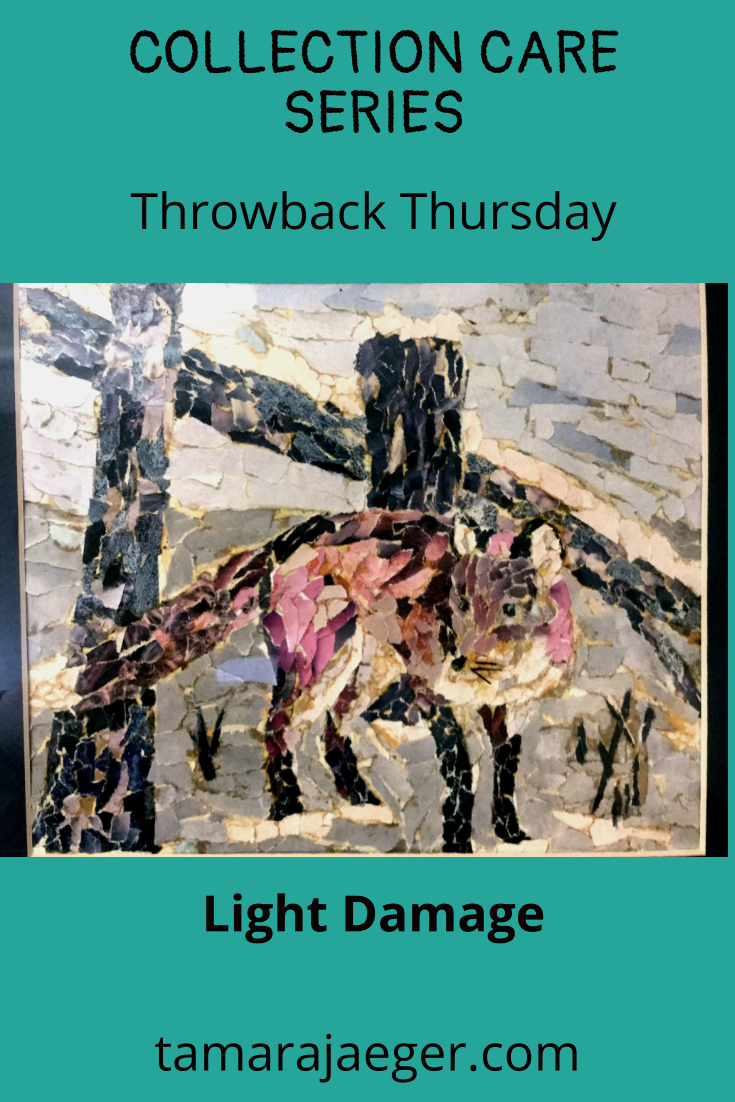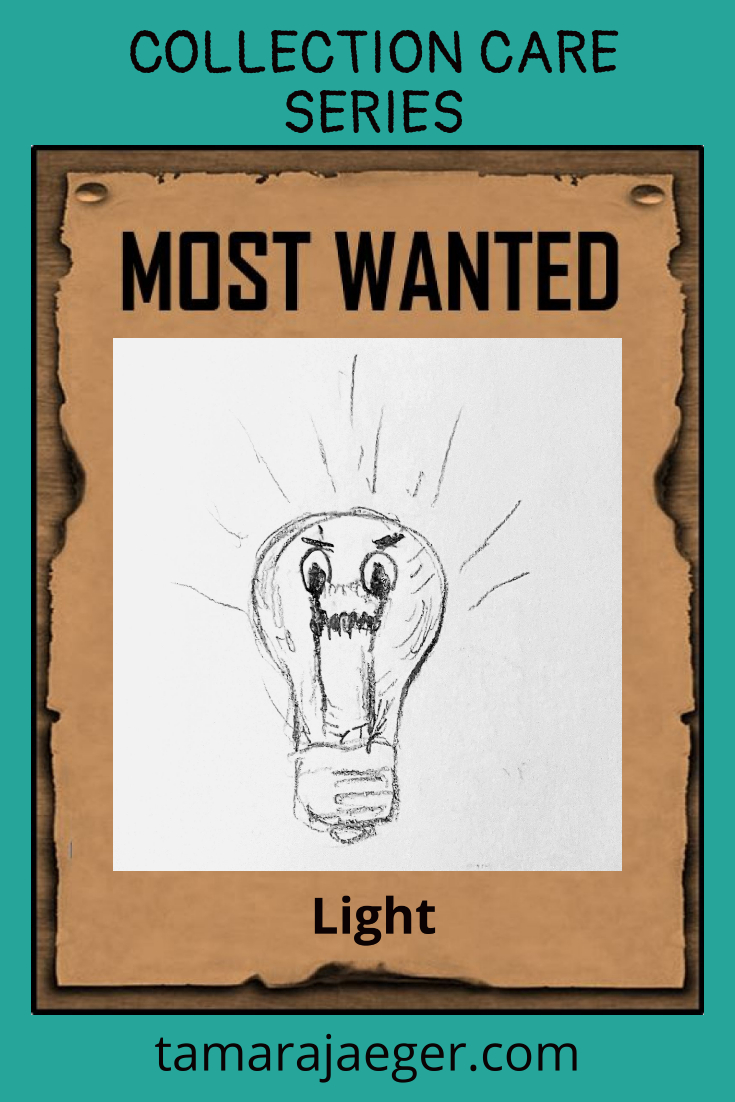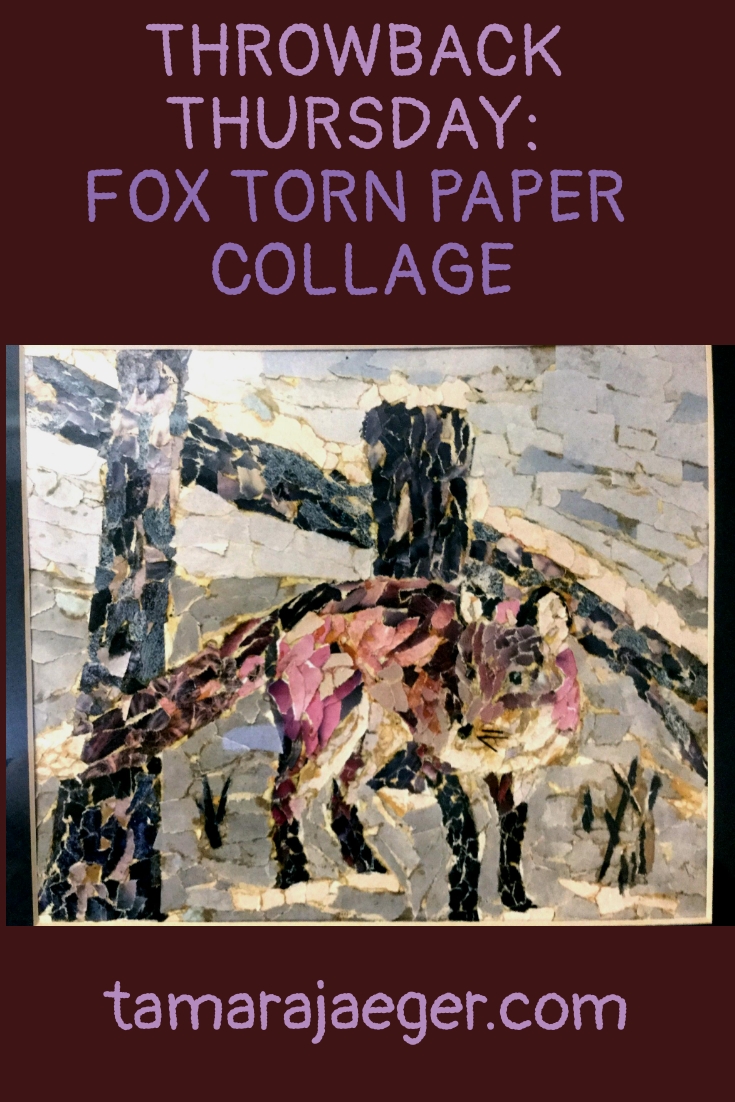Posts Tagged: light damage


Collection Care Series Throwback Thursday: Fox Collage
Last week we talked about light damage. So as an example, I wanted to share with you one of my earliest torn paper collages. Now, as far as preservation goes, it’s had a rough life. It was displayed for over 20 years right next to a window in an office. It got a Lot of light, and you can definitely see the effects of that.
Unfortunately, I don’t have a photo of what it looked like when it was first made, but you can still see the fading and discoloration. Some of the discoloration is of the adhesive used to attach the magazine pieces to the paper—that’s likely a combination of light damage and the acidic nature of the adhesive (rubber cement, in this case).
Overall, considering the amount of light it got, it’s in surprisingly good shape. The colors have shifted, the blues in particular have faded a lot, but it’s still apparent what the subject is. At least it provided a lot of enjoyment over its lifetime!

Do you have any examples of light damaged artwork? Feel free to share in the comments!
Missed the first post? Start at the beginning of the collection care series here.
Check out the next collection care post on moisture here.
Want to stay up to date and see more of what I’m working on? Sign up for my mailing list here and get a FREE collection care resource guide. (I promise not to be spammy with my emails—I hate that too!)


Collection Care Series: Enemy #1: Light
Fun fact: I actually trained and worked as a museum conservator for a number of years. I specialized in archaeological and ethnographic materials, but also covered the basics of conservation of most traditional fine art and decorative art materials—you never know what you’re going to encounter, particularly with ethnographic objects!
Everyone has their ‘treasures’ that they want to preserve for as long as possible, right? Maybe it’s a crayon drawing from your first child. Maybe it’s something you inherited from your grandparents. Or maybe it’s a piece of art you got at a fair and just really enjoy. Whatever it is, you want it to last, so I thought it might be helpful to go over basic care information for some of the more common materials found in peoples’ houses. We’ll do this as a multi-part series, where I’ll focus on a different collection risk factor each week and which materials are most at risk. As a bonus, I put together a short guide covering some common items with simple recommendations for storage or display as well as a list of resources where you can get more information or professional conservation services. You can get it here.
Enemy #1: Light
This week, we’ll be talking about the first ‘enemy,’ Light.

Light can cause a lot of damage, particularly UV light. I’m not going to go into the chemistry involved in light damage (I mean, I totally could, but I don’t want to bore everyone to tears!), so just keep in mind that sunlight and fluorescent lights can be particularly damaging.
Some common items that can be damaged by light include paintings, paper, photos and negatives, and plastics. Plastics are actually becoming increasingly common in museum collections and despite all the press about them never breaking down, plastics can degrade quite badly and pose a lot of problems for preservation. So, you know those plastic dinosaurs or toy horses you had as a kid that you want to hang on to? They need a little TLC to keep them in good shape.
On of the main signs of light damage is fading and discoloration. Along with discoloration, many materials will also become quite brittle. Both are signs of the underlying chemical deterioration that is taking place. Places you’ll see light damage are with paintings, particularly things like watercolors, and prints on paper, as well as photos and negatives. You may notice that artwork that was displayed near a window has faded or discolored. Also, some colors are affected more than others, so the overall color of the print will have shifted. Reds and blues are often the first victims of light damage. Plastics will discolor and, if originally colored, will fade as well, often getting a hazy, whitish film on the surface. You see this sometimes on older plastic playground equipment, since it’s exposed to the sunlight all the time.
Now, unfortunately, light damage is cumulative and permanent. If you have something that’s faded or discolored from light, there’s no fixing it. But you can help prevent further damage by limiting the amount of light it’s exposed to in the future. If your treasure hasn’t been damaged by light yet, fantastic! Let’s keep it that way so you can enjoy it for years to come.
As far as preventing light damage, it’s really quite simple: don’t expose your item to a lot of light. I don’t mean you have to keep everything in complete darkness all the time (though that’s the best way to prevent light damage). After all, you still want to enjoy your treasures, otherwise what’s the point? Just keep them away from bright light. Don’t hang them near windows or under fluorescent lights. If you have something like a really old photo you want to display but don’t want to damage (or damage further), consider getting it reprinted on modern photo paper and displaying that. You can then keep the original stored away from light entirely to preserve it as long as possible.
There’s a peculiarity you should know about with oil paintings, however. You should avoid storing oil paintings in complete darkness as this will cause the linseed oil in the paint to darken or yellow. This color change is different from the light damage we’ve been talking about, however, and actually can be reversed by placing the painting in natural light for a few days.
Do you have any treasures that you think are vulnerable to light damage? Let me know in the comments!
Check out the next post in the collection care series here.
Want to stay up to date and see more of what I’m working on? Sign up for my mailing list here and get a FREE collection care resource guide. (I promise not to be spammy with my emails—I hate that too!)


Throw Back Thursday: Fox Torn Paper Collage
This was probably my very first animal ‘portrait’ torn paper collage! I made it over twenty years ago and it’s spent most of that time hanging near a window in a brightly lit office. Considering the less-than-ideal environment where it’s spent its life, I’m actually pretty impressed that it still looks as good as it does.

Really though, I suppose the important thing is that it’s spent the last 20 years being enjoyed instead of stuffed in a dark corner somewhere!
All artwork will deteriorate over time, that’s just the nature of things. However, here is some advice on how to display your torn paper collage pieces in a way that will provide the longest period of enjoyment:
- The greatest danger is light, which will cause fading of the inks used in the magazines and catalogs that were used to create the piece. Please avoid exposure to direct sunlight or prolonged exposure to fluorescent lighting.
- Due to the delicate surface texture, your torn paper collage artwork is best displayed framed under UV filtering glass with archival quality mats.
- Keep your artwork in conditions that feel comfortable to you—avoid storing the artwork in very hot places, such as an attic or garage. Also avoid very damp areas, like basements, which can lead to mold growth.
If you have any questions about how to best preserve or display your torn paper collage artwork, please don’t hesitate to contact me here or by email at tamara@tamarajaeger.com. I’m always happy to help!
Want to keep updated and see more of what I’m working on? Sign up for my mailing list here and get a totally FREE digital download of a tiger linocut print. (I promise not to be spammy with my emails—I hate that too!)